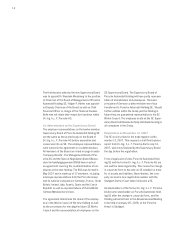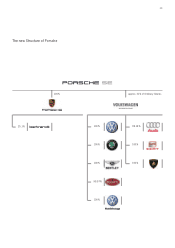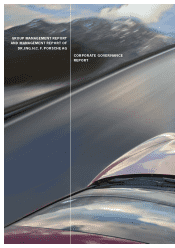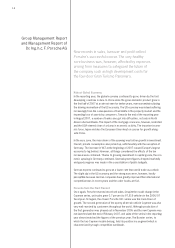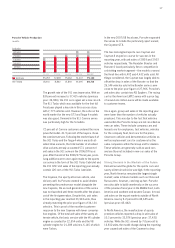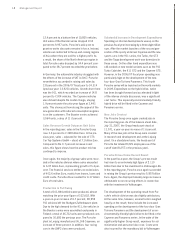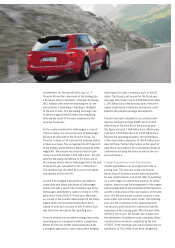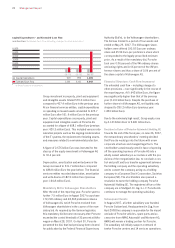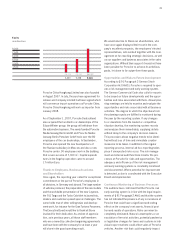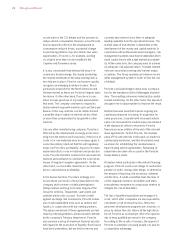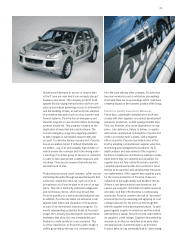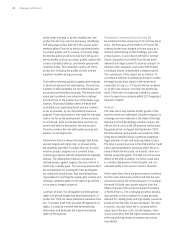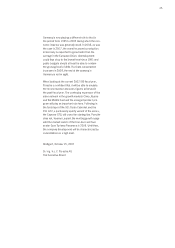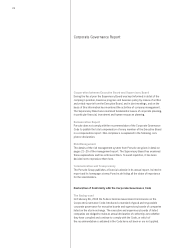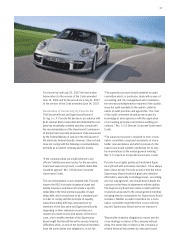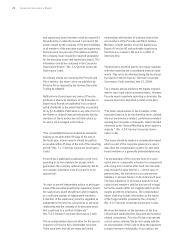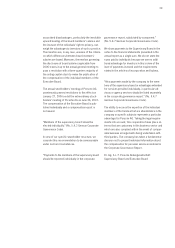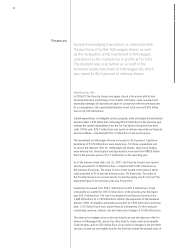Porsche 2006 Annual Report Download - page 24
Download and view the complete annual report
Please find page 24 of the 2006 Porsche annual report below. You can navigate through the pages in the report by either clicking on the pages listed below, or by using the keyword search tool below to find specific information within the annual report.on unit sales is the CO2debate and the pressure to
reduce vehicle consumption. However, since Porsche
has increased its efforts in the development of
consumption-reduced drives, a potential change
in purchasing patterns may also harbor new sales
opportunities. Porsche is, for example, working
on a hybrid drive that is to be installed in the
Cayenne and Panamera series.
It is also conceivable that demand will drop if re-
cessionary trends emerge. By closely monitoring
the market and thanks to the early warning indica-
tors that are in place, Porsche can however quickly
recognize an emerging downturn in sales. This is
particularly important for the North American and
German market as these are Porsche’s largest sales
territories. On the other hand, Porsche is in a po-
sition to make good use of any sales opportunities
that arise. The company continues to expand its
dealer network in growth markets such as China and
Russia. In this way, vehicles can be redirected and
a possible drop in sales in a market can be offset
or more than compensated for by growth in other
markets.
Like any other manufacturing company, Porsche is
affected by the development in energy prices stem-
ming from the market and fiscal policy. If the price of
crude oil or raw materials were to increase again, it
cannot be entirely ruled out that this will negatively
impact on Porsche’s profitability. Any price increase
leads indirectly to a rise in materials and production
costs. Porsche therefore monitors the raw materials
markets and endeavors to minimize the cost risk by
means of long-term supplier agreements. On the
other hand, a conceivable reduction in raw materials
prices could enhance profitability.
In the finance function, Porsche’s strategy is to
secure those currencies of most importance to the
company and to ensure a stable planning basis
taking medium and long-term sales targets of the
Group for vehicles, Tequipment, spare parts and
optional articles into account. To protect itself
against exchange rate movements, Porsche makes
use of well-established tools such as options and
futures, in cooperation with top-ranking partners.
The nature and extent of these agreements are laid
down by internal guidelines and processed centrally
by the company’s Treasury department. Porsche
also pursues a policy of maximum financial security
with regard to the assurance of liquidity. Bond issues
have been undertaken, but are held in reserve and
currently earn interest since there is adequate
liquidity available from the operative business. The
market value of investments is dependent on the
development of the money and capital markets. In
cooperation with professional asset managers, risk
management systems have been established which
avoid capital losses with a high statistical probabil-
ity. At the same time, the company aims to achieve
an adequate, risk-adjusted return. Possible interest
risks are secured by entering into interest swaps
or options. The Group operates an intensive receiv-
ables management system in order to limit the risk
of default.
Porsche concluded hedge transactions in prepara-
tion for the mandatory bid to Volkswagen sharehol-
ders. The resulting risks were minimized by careful
market monitoring. On the other hand, this approach
also gave rise to opportunities to improve the result.
Another business area that requires ongoing pre-
cautionary measures is leasing. Its expansion for
some years now, in parallel with increased vehicle
sales, has increased the residual value risk involved
in the disposal of vehicles returned to Porsche
financial services entities at the end of the relevant
lease agreements. To limit this risk, the residual
value of Porsche vehicles in the used car market is
continuously monitored, and this information used
as a basis for establishing the residual value in
future leasing vehicle agreements. Remaining re-
sidual risks are taken into account in the Porsche
Group balance sheet.
At dealers which participate in the vehicle financing
program, Porsche carries out ratings of contractual
partners in order, among other things, to determine
the amount of financing, the necessary collateral
and the term. A credit committee fixes the lines of
credit, regularly monitors receivables and takes
precautionary measures at conspicuous dealers to
mitigate the risk of bad debts.
The loss of qualified specialists and managers is
a risk, which other companies are also exposed to,
constitutes a risk of know-how loss. Attractive
personnel development programs are, however, in
place to reduce this risk. Above all the high attrac-
tion of Porsche as an employer offers the opportu-
nity to keep qualified personnel in the company.
According to the results of surveys, the appeal of
Porsche as employer on young people can also be
a competitive advantage.
22 Management Report


